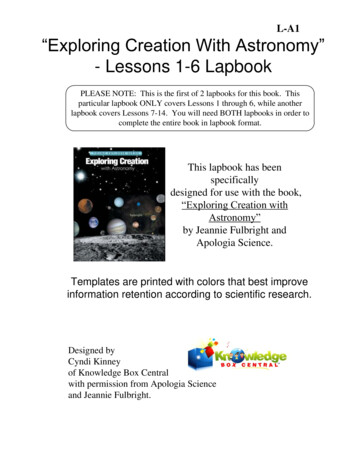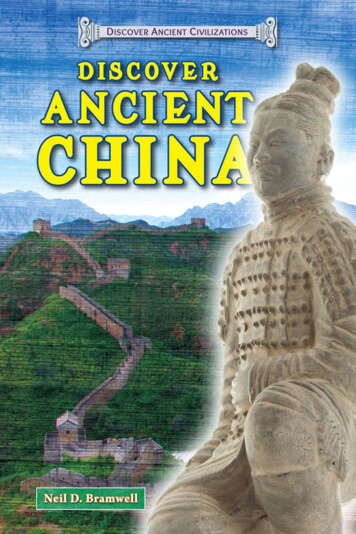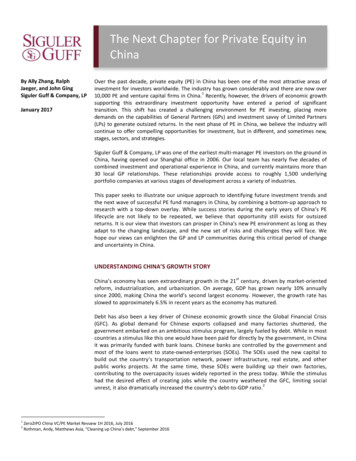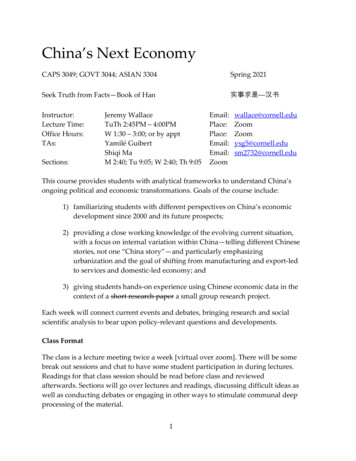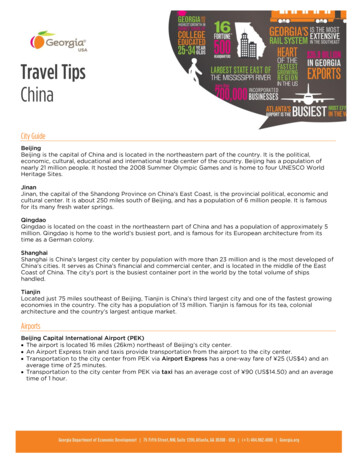
Transcription
Ancient ChinaLapbookMaterials and information may be used for your own personal and school use.Material may not be used for resale or shared electronically. Homeschool Share
Ancient China Lapbookstudy by JimmieBasic TimelineAncient China includes just three dynasties:1. Zhou Dynasty 1100 - 221 BC--Confucius lived 551 - 479 BC2. Qin Dynasty 221 - 210 BC--Unification of China under Qin Shi Huang Di3. Han Dynasty 206BC - 9 AD--Flowering of Chinese culture--invention of the kite and of paper--Buddhism introduced into China--Silk Road opensCreate an accordion book with the timeline figures.Emperor QinRead the information in the file and create a mini-book.Terracotta SoldiersRead The Emperor's Silent Army: Terracotta Warriors of Ancient China by JaneO' Connor (if possible). If you can't get the book, just read the information in the
file. Read through the Terracotta information and complete the trifold book.If desired, watch this video a man making a replica of a Terra Cotta Warrior.Great WallRead The Great Wall of China by Leonard Everett FisherComplete Great Wall ¾ book and read through the Great Wall information.If desired, watch this video about The Great Wall.ConfuciusRead Confucius Information and complete the Confucius shutterflap and theConfucius Quotes copywork & pocket.Ancient Chinese BookPaper was invented in the Han Dynasty (206 BC - 220 AD). But before theinvention of paper, books were made with strips of bamboo tied together withstrings. Then the books could be rolled up like a scroll. Add Ancient Chinesebook to your lapbook.Ancient Chinese MoneyBy 400 B.C., China was using bronze coins for money. The coins had square holesin the middle so that people could keep them on a ribbon or stick.For extra fun for your lapbook, make some coin replicas. Roll some Sculpey clayflat with a rolling pin. Cut circle shapes out. Punch a square shape in the middleof each coin. Bake according to directions on package. When the coins arecool, paint them with bronze or gold craft paint. After the paint dries, add someChinese characters with a black permanent marker. Run a ribbon through your
coins. Make a special pocket (you may want to use a small plastic bag) and storethem in your lapbook.Ancient Chinese InventionsRead Made in China: Ideas and Inventions from Ancient China by SuzanneWilliamsComplete Kite mini-book OR complete Ancient Chinese Inventions Windowbook.Note: The kite may be best suited for one invention while the window book canbe used to record information about three different inventions.Silk RoadRead The Silk Route: 7,000 Miles of History by John S. Major.The production of silk began during the Shang Dynasty (1750 - 1100 BC). Thesecrets of spinning silk worm cocoons into luxurious fabric was a closelyguarded secret for many years. During the Han Dynasty, the Silk Road opened,taking Chinese made silk the 7000 mile journey across Central Asia to theEastern Roman Empire in Byzantium.Make a three-square unfolding book. Open it up and draw the silk route basedon the information in The Silk Route: 7,000 Miles of History (make it godiagonally through the center- see picture below). If desired, add the lifecycleof the silkworm on the outside empty squares. You can find nice images of the
silkworm's lifecycle here (see silkworm sequencing cards).Decorate your lapbook or make more mini-books with the extra images.LinksEllen McHenry's Basement WorkshopAncient China Unit Study Squidoo LensLearning Page Great Wall Fact Sheet #30How to Make PaperRecommended BooksLife in Ancient China by Paul ChallenThe Emperor's Silent Army: Terracotta Warriors of Ancient China by Jane O'ConnorThe Great Wall of China by Leonard Everett FisherMade in China: Ideas and Inventions from Ancient China by Suzanne WilliamsAdventures in Ancient China (Good Times Travel Agency)The Silk Route: 7,000 Miles of History by John S. MajorThe Emperor and the Kite by Jane YolenYou Wouldn't Want to Work on the Great Wall of China! by Jacqueline MorleyYeh-Shen by Ai-Ling Louie
Zhou Dynasty BeginsConfuciusZhou Dynasty EndsQin Dynasty BeginsThe Great Wall andTerracotta WarriorsAre Built.Qin Dynasty EndsHan Dynasty BeginsKite and Silk areInvented.Silk Road OpensHan Dynasty EndsDirections for timeline.Use four index cards (or cardstock/paper cut to that approximate size) to make an accordion book. Decorate the frontand make a title (Ancient China Timeline) Print the eventsand pictures above. Inside, use two timeline items per page.Fill in the dates.1Dates are as follows:Zhou Dynasty begins 1100 BCConfucius 551-479 BCZhou Dynasty ends/Qin begins 221 BCGreat Wall/Terracotta built during Qin’s reign 221-206 BCQin Dynasty ends/Han begins 206 BCKite, silk invented; Silk Road Opens during Han Dynasty206BC -220 ADHan Dynasty ends 220 AD
Qin Shi Huang Di built a long wall with watchtowers along the northernborder of his empire to keep out the invading Huns. This wall linked manyof the already existing walls that were built under the rule of the variouskingdoms before he came to power. Some have called it the longestcemetery in the world because of all the people who died during its construction. Peasants and criminals were forced to work as slaves to build it.Furthermore, high taxes were exacted to finance this project.The Great Wall is almost 4000 miles long and crosses approximately 1400miles of land. The emperors of later dynasties rebuilt and extended QinShi Huang Di's original project. (The Great Wall that is visible today wasconstructed under the rule of the Ming Dynasty.)
Cut away this fourthFCIT http://etc.usf.edu/clipart
Qin Shi Huang Di was superstitious and afraid of death. He hired fortune tellers and magicians to find the secret to immortality. Ironically it is thought that his death at age 49 wasbrought on by the consumption of mercury, a common ingredient in these elixirs.The greatest evidence of his obsession with death is his construction of his tombs. Thousandsof laborers worked for up to 40 years to make clay models of an entire army - 7000 soldiers,600 horses, 10 chariots, and a multitude of weapons and suits of armour. This army wasmeant to protect him in the afterlife. His own body is buried in a replica of his palace in a yetunexcavated underground tomb.The terracotta warriors were made with local clay pressed in molds of body parts. Thesemolded parts were assembled with a clay paste and facial and armour details were added.Finally each warrior and horse was fired in a huge kiln, painted in brilliant colors and assembled in ranks in the underground tombs.Activity: Kitchen Terra CottaThis activity is taken from Marco Polo for Kids by Janis Herbert.What you need:Oven1 . cups boiling water Pot1 cup salt Spoon2 cups flour BowlCutting board Red and orange food coloring4 T. paprika ToothpicksCheese grater Cookie sheet1. Preheat the oven to 250 degrees F. Boil the water in the pot, then stir in the salt. Place the flour inthe bowl. Pour the salt water into the flour and mix with the spoon. Divide into four pieces.2. Place one piece on the cutting board and drip 8 drops of yellow and 4 drops of red food coloringonto it. Sprinkle with 1-T. paprika. Knead until the color is distributed, then shape the clay into soldiers, horses, or evil emperors! (Some tips: Roll pieces of clay into balls to make head and eyes. Rollout clay “worms” for legs and arms. You can use toothpicks to carve details. Push a piece of claythrough a cheese grater to make hair.)3. Repeat with other pieces. Place the finished pieces on the cookie sheet, put them in the oven, andbake for 2 hours, until dry
兵马俑backFOLDFOLD
Cut book on previous page out as onepiece. Tri-fold. Use inside to recorddiscoveries about Qin Shi Huang Di.When you think of Ancient China, probably top on your list of associations areThe Great Wall and the Terracotta Soldiers. Both of these monuments were built under the reignof Qin Shi Huang Di.At the end of the Zhou Dynasty, many states were warring against each other and taking eachothers' lands until only seven states remained. One of those was the Qin Kingdom. In 221 BCthe ruler of the Qin Kingdom took over the other six kingdoms and pronounced himself the firstemperor with the title Qin Shi Huang Di. He is also known as the Yellow Emperor because hechose that color for his royal clothes.Qin Shi Huang Di's major accomplishments were to unify China with standard measures, coinage, weights, and Chinese characters. He also ordered the construction of irrigation systems,bridges, roads, and canals. Legislating these changes brought more unity to China than had everbeen experienced before. Trade and communication within China became easier than before.He wanted to do away with feudalism and old ways of thinking. Qin Shi Huang Di took away thenobles' land and forced them to live with him at his capitol so that he could control them. Theland was available for sale and officials were sent to each area to collect taxes and to rule according to Qin Shi Huang Di's strict legalist government. Those who broke the laws were punished severely - often being forced to serve as slave labor for his projects, including the Terracotta Army and the Great Wall. Books of literature, philosophy, and history were burned underhis rule. He also ordered the execution of more than 400 Confucian scholars.Qin is pronounced "Chin." This is the sound from which the modern name China comes.
Qin ShiHuang
Window book with 4 windows.Indicatestain fold.valleymoun-Before cutting, use apencil to lightly label/number the pages according to the numbers in the margin.Later you can erasethese marks.Cut on solidlines; fold ondotted lines.BACKChinaMade inCOVERIndicatesfold.
PAGE 6GLUE THIS PAGETO INSIDE OFCOVER/BACK.PAGE 1Indicatesfold.valley
PAGE 2valleyIndicatestain fold.moun-PAGE 5Indicatesfold.
PAGE 4G LU ET H ISSHEET TOINSIDE OF PP2/5.PAGE 3Indicatesfold.valley
Cut shape out as one piece. Fold flaps (this has to be done precisely to fitright). Use the book to write about different Chinese inventions. A good goalong book is Made in China by Suzanne Williams. Add string and bows toyour kite shape book. Paste the back of the book to your lapbook.
ConfuciusHis works were banned and burned under Qin Shi Huang Di in the Qin Dynasty. But during thelater Han dynasty, Confucius' works were renewed and adapted into what became State Confucianism.GoalThe goal of Confucianism is to realize a harmonious state in which perfect order prevails, andvirtuous men are rewarded. Virtue consists of filial piety, fulfillment of duty, and the good example of superiors.TeachingsHierarchy of the 5 Cardinal Relationships:1. Ruler and ruled2. Parents and children3. Husband and wife4. Older and younger brother5. Friend and friendProverbs A man who has committed a mistake and doesn't correct it is committing another mistake. If the ruler is upright, all will go well in his country. Bad government is more terrible than tigers. The strength of a nation derives from the virtue of the home. A gem can't be polished without friction, nor a man perfected without trials. What you do not want done to you, do not do to others. Consideration for others is the basis of a good society. The sage knows what is right; the fool knows what will sell. The sage demands much of himself; the fool demands much of others. Real knowledge is knowing the extent of one's ignorance.Personal Reflections by ConfuciusAtAtAtAtAtAt15,30,40,50,60,70,I set my mind on learning.I took my stand.I no longer had doubts.I knew the will of Heaven.my ear was attuned.I follow my heart's desire.Information from http://www.vhinkle.com/china/confucianism.html
孔子clipart courtesy FCIT; http://etc.usf.edu/clipartCut awayCut awayConfuciusfoldbackDuringtheHan DynastyDuringtheQin Dynastysayingsfoldfoldbackteachings
%NMETBHTR 5@HC PDQ ZKR KDV FRPPLWWHG D PLVWDNH DQG GRHVQW FRUUHFW LW LV FRPPLWWLQJ DQRWKHU PLVWDNH CCCCCCCCCCCCCCCCCCCCCCCCCCCCCCCCCC http://www.homeschoolshare.com
%NMETBHTR 5@HC ,I WKH UXOHU LV XSULJKW DOO ZLOO JR ZHOO LQ KLV FRXQWU\ CCCCCCCCCCCCCCCCCCCCCCCCCCCCCCCCCCCCCCCCCC &DRBQHAD @M 7OQHFGS 4TKDQ CCCCCCCCCCCCCCCCCCCCCCCCCCCCCCCCCCCCCCCCCCCCCCC http://www.homeschoolshare.com
&Q@V 2HBSTQD NE VG@S @ A@C FNUDQMLDMS KNNJR KHJD %DG JRYHUQPHQW LV PRUH WHUULEOH WKDQ WLJHUV CCCCCCCCCCCCCCCCCCCCCCCCCCCCCCCCCCCCCCCCCC http://www.homeschoolshare.com
%NMETBHTR 5@HC 7KH VWUHQJWK RI D QDWLRQ GHULYHV IURP WKH YLUWXH RI WKH KRPH CCCCCCCCCC .NNJ TO @MC CDEHMD SGD VNQC UHQSTD CCCCCCCCCCCCCCCCCCCCCCCCCCCCCCCCCCCCCCCCCCCCCCCCCC http://www.homeschoolshare.com
%NMETBHTR 5@HC &RQVLGHUDWLRQ IRU RWKHUV LV WKH EDVLV RI D JRRG VRFLHW\ CCCCCCCCCCCCCCCCCCCCCCCCCCCCCCCCCCCCCCCC *NV CN XNT RGNV BNMRHCDQ@SHNM ENQ NSGDQR" CCCCCCCCCCCCCCCCCCCCCCCCCCCCCC http://www.homeschoolshare.com
%NMETBHTR 5HDO NQRZOHGJH LV NQRZLQJ WKH H[WHQW RI RQHV LJQRUDQFH CCCCCCCCCCCCC http://www.homeschoolshare.com
If you would like to include copywork in a lapbook, fold in quarters and store in pocket. 3TNSDR X %NMETBHTR http://www.homeschoolshare.com
Jimmie’s guide for making an Ancient Chinese book.I gathered an exacto knife, a cutting board, wooden craft sticks, a ruler, and a pencil.I measured about one cm from the top of the sticks on both tips and marked it lightly.My next step was to cut notches where I'd drawn the line. I used a marker here to make itclear for you.
This is for the adult to do, obviously.Then DD tied the sticks together with rafia, making sure the rafia fit into thegrooves I'd cut. Twine or jute would work well too. But we had rafia.
5. Lastly DD wrote Chinese characters on the sticks going up and down.Well, some of her characters are a bit creative. Chinese people may notrecognize them. But to you it looks great, right? It looks just like /Jimmie/369189/
Ancient China Lapbook study by Jimmie Basic Timeline Ancient China includes just three dynasties: 1. Zhou Dynasty 1100 - 221 BC --Confucius lived 551 - 479 BC 2. Qin Dynasty 221 - 210 BC --Unification of China under Qin Shi Huang Di 3. Han Dynasty 206BC - 9 AD --Flowerin


